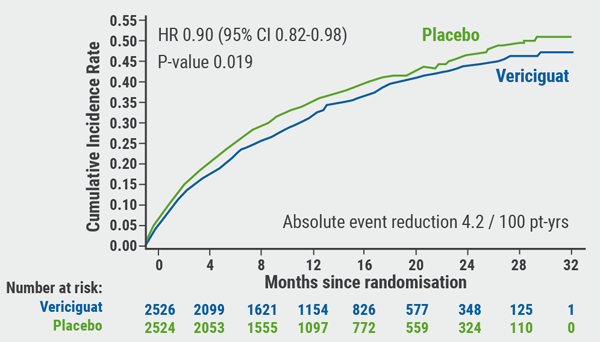Prof. Nadia Rosencher (Paris Center University Hospital, France) and colleagues in the PRONOMOS trial aimed to compare the effect of rivaroxaban with that of enoxaparin in preventing major VTE during immobilisation after lower-limb non-major orthopaedic surgery [1]. The trial enrolled 3,604 adult patients who underwent non-major orthopaedic surgery of the lower limbs and who required thromboprophylaxis for >2 weeks (investigator’s assessment). The primary efficacy endpoint of the study was major VTE, a composite of symptomatic distal or proximal deep-vein thromboembolism (DVT), pulmonary embolism, or VTE-related death during the treatment period, or asymptomatic proximal DVT at the end of treatment. Safety outcomes were major and clinically relevant non-major bleeding. Participants were enrolled between December 2015 and April 2018 at 200 sites in 10 countries. As recruitment of patients was slower than expected, enrolment was terminated early due to drug supply issues. Participants had a mean age of 41 years and median body mass index of 26.3 kg/m². Many types of surgery were included in the study (median duration 60 minutes), with the most common being ligament repair of the knee, ankle fracture, and knee arthroscopy. A prophylactic dose of low-molecular-weight heparin was given prior to surgery to 13.8% of patients. The patients were randomised to receive 10 mg oral rivaroxaban and a placebo injection (n=1,809) or enoxaparin (40 mg in 0.4 mL of diluent) plus a placebo oral tablet (n=1,795).
The results showed that 0.2% of patients on rivaroxaban experienced VTE (n=4) versus 1.1% of patients receiving enoxaparin (n=18; risk ratio [RR] 0.25; 95% CI 0.09-0.75; P<0.001 for non-inferiority, P=0.01 for superiority). Symptomatic VTE was seen in 0.2% versus 0.6% of patients, respectively (RR 0.28; 95% CI 0.08-1.00). Asymptomatic proximal DVT was seen in 0.1% of the rivaroxaban group versus 0.4% of the enoxaparin group. Major and non-major clinically relevant bleeding occurred in 1.1% of rivaroxaban patients and 1.0% of enoxaparin patients (RR 1.04; 95% CI 0.55-2.00). Although this study was prematurely stopped because of low accrual, and is therefore limited in impact, the net clinical benefit of VTE + major bleeding was 0.8% for rivaroxaban and 1.8% for enoxaparin (RR 0.48; 95% CI 0.26-0.90). These findings suggest that rivaroxaban could replace enoxaparin to prevent VTE during postoperative reduced mobility after non-major orthopaedic surgery in at-risk patients.
- Samama CM, et al. Abstract 406-11. ACC/WCC 28-30 March 2020.
- Samama CM, et al. N Engl J Med. 2020. DOI:10.1056/NEJMoa1913808.
Posted on
Previous Article
« ISTH 2020 Highlights Podcast Next Article
Apixaban offers new perspective for cancer patients in need of anticoagulation »
« ISTH 2020 Highlights Podcast Next Article
Apixaban offers new perspective for cancer patients in need of anticoagulation »
Table of Contents: ACC/WCC 2020
Featured articles
Heart Failure and Cardiomyopathies
Mavacamten shows promising results in non-obstructive hypertrophic cardiomyopathy
Vericiguat shows beneficial effects in a very high-risk HF population
No role for sodium nitrite in out-of-hospital cardiac arrest
Vascular Medicine and Thromboembolism
Rivaroxaban and aspirin effective and safe for PAD patients
TAILOR-PCI misses endpoint but still provides valuable insights
Edoxaban: alternative to warfarin after surgical aortic or mitral valve procedures?
Bleeding reduction post-TAVI with OAC alone vs OAC + clopidogrel
Apixaban offers new perspective for cancer patients in need of anticoagulation
Rivaroxaban superior to enoxaparin in preventing VTE in non-major orthopaedic surgery
Interventional Cardiology
TAVR safe and effective in low-risk bicuspid aortic stenosis patients
TAVR model reveals differences in hospital outcomes
2-year results show non-significant outcomes TAVR vs surgery in severe aortic stenosis
Renal denervation better than sham for blood pressure
Infusion of ethanol in the vein of Marshall for persistent AF
Atrial Fibrillation/Acute Coronary Syndrome
Fewer adverse events with ticagrelor monotherapy after 3 months DAPT
TWILIGHT sub-study: same outcomes for diabetes patients
TWILIGHT sub-study: complex PCI patients
LAAO Watchman registry data positive
Apixaban in AF patients with recent ACS/PCI: Drop aspirin after 30 days
Genetics and Prevention
Homozygous FH responds to alirocumab
Evinacumab significantly reduces LDL-C in homozygous FH patients
Higher serum levels of eicosapentaenoic acid correlate with reduced CV events
Quit smoking: vaping + counselling helps
Related Articles
September 8, 2020
Real-world evidence for MitraClip

September 7, 2020
Vericiguat shows beneficial effects in a very high-risk HF population

© 2024 Medicom Medical Publishers. All rights reserved. Terms and Conditions | Privacy Policy
HEAD OFFICE
Laarderhoogtweg 25
1101 EB Amsterdam
The Netherlands
T: +31 85 4012 560
E: publishers@medicom-publishers.com

